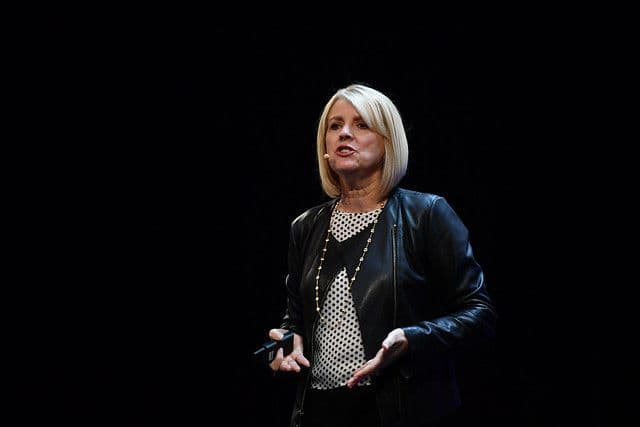Collision Conf 2019: Grappling with Marketing’s Messy, Promising Future
Published on May 28, 2019/Last edited on May 28, 2019/8 min read


Todd Grennan
Content Production Principal, Content Marketing at BrazeThe customer engagement landscape is in a state of flux—but, then again, when isn’t it? In the years since the launch of the iPhone, emerging technologies and shifting consumer preferences and behavior have left marketing, growth, and engagement teams in a prolonged sprint, trying to keep up with the changes happening all around them. As Hilton CMO Kellyn Smith Kenny said at this year’s Collision Conf, “If you stand still for even one year, the next year you’ll feel like you’re ten years behind.”
Staying ahead of that curve has always been a central focus of Collision. This year’s edition of the conference, which took place May 20–24 in Toronto, featured VCs and researchers, athletes and musicians, founders and titans of industry, all of them in conversation about where technology is taking us and the costs and opportunities that await humanity in the days to come. And while a mind boggling number of topics were covered during the event—from AI to healthtech to Hyperloop technology and the future of global payments—when it came to customer engagement, the same three themes kept bubbling up again and again:
1. Data is central to customer/brand relationships—but too many brands aren’t taking data privacy seriously enough
Data has been at the heart of marketing for years. From the era of spreadsheet marketing to today’s increasingly fluid, data-driven customer engagement strategies, data—particularly first-party customer data—has made it possible for brands to better understand their customers and to better meet their needs.
But new advances in technology and the rise of built-for-purpose customer engagement ecosystems constructed on a foundation of data streaming has made it possible for companies to more effectively engage and build relationships with consumers than ever before. “Data has always been leveraged,” Jaya Kohlatkar, chief data officer at Hulu, told attendees, “but having it under one roof, being able to connect data from different parts of your business...it’s the next place people need to be on their data journey.”
Since 2016, however, we’ve seen the darker side of this story emerge. As Rebecca Kaden, general partner at Union Square Ventures, noted, “The sheer number of data breaches and hacks points to…a failure to secure [systems] effectively.” And as the frequency of those data breaches grows, scandals like Cambridge Analytica dominate the headlines, and regulators in countries around the world increasingly mull (and even implement) strong new data privacy laws, there’s a sense that the world is changing, that the mobile era’s customer data gold rush may finally be at an end.
But while changing customer attitudes around data privacy and strict legislation like the European Union’s General Data Protection Regulation (GDPR) and the California Consumer Privacy Act (CCPA) are increasing the financial and legal risks associated with thoughtless handling of private consumer data, many companies aren’t keeping up with the shift. The past year has brought GDPR investigations of companies like Facebook, Google, Quantcast, among others, a trend that seems likely to grow as CCPA comes into effect in January 2020.
One possible way forward? Better data about data. At Collision, 11.2 Capital Founder and Managing Partner Shelley Zhuang argued that, “Over time, data privacy is going to be a metric, bias another metric,” making it easier for brands and their customers to understand and assess what’s being done with customer data and to make changes when issues are identified.
2. When it comes to marketing, the old teams structures are being upended—but brands shouldn’t take a one-size-fits-all approach
As customer engagement ecosystems and the technologies that power them have become more powerful and more flexible over the last decade, there’s a growing awareness—especially among traditional enterprise brands—that marketing strategies built around channel silos and single-focus teams need to be reconsidered. As Hilton’s Kenny said, “Marketing itself is being disrupted…you need to make sure you’re poised to take advantage of all the technology and all the efficiency out there.”
Modern customer engagement’s focus on responsiveness, speed, and scalability has led many marketing, growth, and engagement departments to take a page from product and engineering teams by exploring Agile methodologies in connection with their team structures and processes. According to Kenny, this focus on Agile during her tenures at Capitol One, Uber, and Hilton, all of which embraced aspects of Agile, was instrumental in driving more effective collaboration and better customer engagement outcomes across the board.
However, Kenny cautioned that implementing Agile effectively requires companies to shy away from a one-size-fits-all approach and explore how best to adopt the aspects of Agile that will serve your specific organization. At Capital One, that meant breaking up single-focus teams and creating a system of cross-functional pods that were empowered to collaborate more effectively; at Uber, it meant taking a holistic view of marketing in the company and using those insights to effectively built and scale the department; and at Hilton, it meant embracing the talent already on the marketing team while breaking down regional silos that were limiting the reach of that global brand.

Cisco's Karen Walker at Collision Conf. Photo by Sam Barnes/Collision via Sportsfile
While technology is increasingly key to strong marketing outcomes, technology alone can’t produce great customer experiences—as Zetta Venture Partners Managing Director Jocelyn Goldfein told attendees, “the quality of the team is the greatest predictor of success” for companies. But while making significant adjustments to how teams are put together and operating can be painful, it also has the potential to transform a company’s customer engagement efforts in a positive way. “It’s an incredibly exciting time in marketing, and we’re just getting going,” Karen Walker, CMO at Cisco Systems, said. “With the right technology and the right balance, we can be a change driver for our customers.”
3. The platform economy is bigger than ever—but smart brands are doing what they can not to lean too much on any one of them
Today’s brands are operating in a platform economy dominated by a small number of enormously influential tech giants—in particular, Google, Apple, Facebook, and Amazon, known collectively as GAFA. Whether you’re buying ads, launching an app, driving web visitors to your site, engaging customers on social media, or even just trying to store and process the user data you’ve collected, the odds are that your company will find itself depending on a GAFA-owned product or service in one form or another.
In some ways, these platforms can be a blessing for brands. If your brand does a great job with SEO and makes its way to the top of a high-traffic search page on Google, traffic will naturally follow—and having only one search engine to worry about makes it easier to focus your efforts. But that influence can cut both ways. Brands—especially in the news and media space—have found themselves repeatedly burned by Facebook, for instance, most notoriously in connection with its support for a supposed “pivot to video” that never panned out.
But while some of the bloom has come off these major platforms, thought leaders at Collision cautioned that the future for brands isn’t a platformless one—instead, smart brands are embracing balance. “It’s really about knowing your audience and knowing how they’re spending time on various platforms,” Viacom Digital Studios President Kelly Day said. “One size fits all; we’ve moved well beyond those days.”

Meg Goldthwaite (center) speaking at Collision Conf. Photo by Vaughn Ridley/Collision via Sportsfile
Every platform presents a risk and an opportunity, but the biggest risk comes from being overly dependent on a single platform overseen by a single company. As National Public Radio CMO Meg Goldthwaite said, “We’re platform-agnostic; we want to be friction-free and wherever you get your news, we want to be there for you.” But while NPR has a presence across a variety of platforms and technologies—from social networks like Facebook to connected devices like Google Homes and Amazon Echos—Goldthwaite cautioned attendees not to leverage a platform or a new technology just because it’s there: “You’ve got to be true to your brand...if an app isn’t right for you, don’t go out and make an app, just so you can have an app.”
Final Thoughts
Marketing is changing. And while no one knows just what the future holds, it seems clear that the customer engagement programs of tomorrow will increasingly depend on thoughtful, compliant data processing, strategic leveraging of major technology platforms, and a more responsive, more collaborative approach to building and running marketing, growth, and engagement teams.
To explore what it can look like for customers when brands get this right (as well as all the painful experiences that come with getting it wrong), check out our exclusive Broken vs. Brilliant video series.
Be Absolutely Engaging.™
Sign up for regular updates from Braze.
Related Content
View the Blog
The new inbox reality: How iOS changes are reshaping email marketing

Aparna Prasad

Experience optimization: Turning data insights into better journeys

Team Braze

December 2025 Bonfire Marketer of the Month: Jagex’s Emma Oliver
